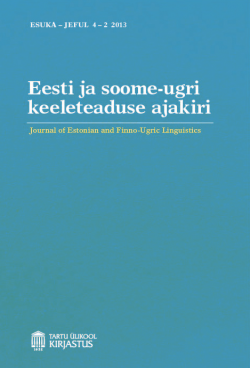Nanai argument structure: Russian influence
DOI:
https://doi.org/10.12697/jeful.2013.4.2.06Keywords:
argument structure, avalent verbs, ditransitive verbs, language contact, Nanai, Tungusic languagesAbstract
The paper investigates two classes of verbs in the Naikhin dialect of Nanai (Tungusic; spoken mostly in the Russian Far East) that demonstrate a certain instability with respect to their argument structure in a situation where there is contact with Russian, the dominating language of the region. The avalent verbs tend to acquire a subject, thus turning into intransitives, while ditransitive verbs reduce the original number of possible argument encoding strategies and preserve the dative-accusative pattern only. The general claim of this article is that although there might be some other reasons (structural, typological, etc.) for the argument structure change in an endangered language, language contact also contributes to the process.Downloads
References
Andersen, Roger W. (1982) “Determining the linguistic attributes of language attrition”. In Richard D. Lambert and Barbara F. Freed, eds. The loss of language skills. Rowley, MA: Newbury House Publishers.
Avrorin, Valentin Aleksandrovič (1959) Grammatika nanajskogo jazyka. Vol. 1. Moskva, Leningrad: Izdatel’stvo Akademii Nauk SSSR.
Avrorin, Valentin Aleksandrovič (1961) Grammatika nanajskogo jazyka. Vol. 2. Moskva, Leningrad: Izdatel’stvo Akademii Nauk SSSR.
Avrorin, Valentin Aleksandrovič (1986) Materialy po nanajskomu jazyku i fol’kloru. Leningrad: Nauka.
Cincius, Vera Ivanovna, ed. (1975) Sravnitel’nyj slovar’ tunguso-man’čžurskix jazykov: Materialy k ètimologičeskomu slovarju. Vol. 1. Leningrad: Nauka.
Cincius, Vera Ivanovna, ed. (1977) Sravnitel’nyj slovar’ tunguso-man’čžurskix jazykov: Materialy k ètimologičeskomu slovarju. Vol. 2. Leningrad: Nauka.
Dorian, Nancy C. (1977) “The problem of the semi-speaker in language death”. International Journal of the Sociology of Language 12, 23–32.
Eriksen, Pål, Seppo Kittilä, and Leena Kolehmainen (2010) “The linguistics of weather: cross-linguistic patterns of meteorological expressions”. Studies in Language 34, 3, 565–601. http://dx.doi.org/10.1075/sl.34.3.03eri
Goldberg, Adele E., Devin M. Casenhiser and Nitya Sethuraman (2004) “Learning argument structure generalizations”. Cognitive Linguistics 15, 3, 289–316. http://dx.doi.org/10.1515/cogl.2004.011
Grenoble, Lenore A. (2000) “Morphosyntactic change: the impact of Russian on Evenki”. In Dicky Gilbers, John Nerbonne, and Jos Schaeken, eds. Languages in contact, 105–120. (Studies in Slavic and General Linguistics, 28.) Amsterdam and Atlanta, GA: Rodopi.
Haspelmath, Martin (2011) “Ditransitive constructions: the verb ‘give’”. In Matthew S. Dryer, and Martin Haspelmath, eds. The world atlas of language structures online. Munich: Max Planck Digital Library, feature 105A. Available online at <http://wals.info/feature/105A>. Accessed on 30.11.2012.
Heine, Bernd (2008) “Contact-induced word order change without word order change”. In Peter Siemund and Noemi Kintana, eds. Language contact and contact languages, 33–60. (Hamburg Studies on Multilingualism, 7.) Amsterdam and Philadelphia: Benjamins.
Kolesnikova, Vera Dionis’evna (1966) Sintaksis èvenkijskogo jazyka. Moskva, Leningrad: Nauka.
Lewis, M. Paul, Gary F. Simons, and Charles D. Fennig, eds. (2013) Ethnologue: languages of the world. 17th ed. Dallas, TX: SIL International. Available online at <http://www.ethnologue.com>. Accessed on 26.02.2013.
Liu, Feng-hsi (2006) “Dative constructions in Chinese”. Language and Linguistics 7, 4, 863–904.
Malchukov, Andrej (2008) Sintaksis èvenskogo jazyka: strukturnye, semantičeskie, kommunikativnye aspekty. Sankt-Peterburg: Nauka.
Malchukov, Andrej, Martin Haspelmath and Bernard Comrie, eds. (2010) Studies in ditransitive constructions: a comparative handbook. Berlin: De Gruyter Mouton.
Malchukov, Andrej and Igor’ Nedjalkov (2010) “Ditransitive constructions in Tungusic languages”. In Andrej Malchukov, Martin Haspelmath and Bernard Comrie, eds. Studies in ditransitive constructions: a comparative handbook, 316–351. Berlin: De Gruyter Mouton.
Nikolaeva, Irina and Maria Tolskaya (2001) A grammar of Udihe. Berlin: Mouton de Gruyter. http://dx.doi.org/10.1515/9783110849035
Ogawa, Akio (2006) “Meteorological and chronological expressions in Japanese and some other languages”. Studia Philologia Universitatis Babes-Bolyai 12, 33–45.
Petrova, Taisija Ivanovna (1935) Kratkij nanajsko-russkij slovar’. Leningrad: Učpedgiz.
Sunik, Orest Petrovič (1985) Ul’čskij jazyk: Issledovanija i materialy. Leningrad: Nauka.
Zaxarov, Ivan (1879) Grammatika man’čžurskago jazyka. Sankt-Peterburg: Tipografija Imperatorskoj Akademii nauk.


